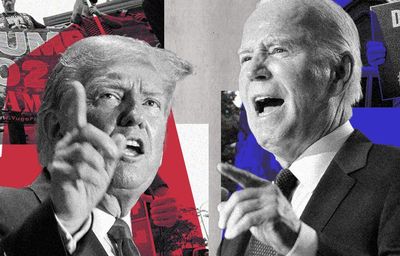The riddle of recovery: Is the economy broken, or is it booming? And is there a secret accelerant no elected official wants to talk about?
Turns out, how folks perceive the economy is often tied more closely to how they vote than to reality. Donald Trump's supporters argue the economy is a disaster of debt and inflation, made worse by an immigration nightmare playing out at the borders. To prove their case, they wander into the Cherry Orchard of Convenient Stats and pick a few choice numbers to make their case.
- US debt has passed $34 trillion and will exceed the dangerous 99% debt-to-GDP ratio.
- Between 60%-78% of US households are living paycheck to paycheck, depending on the survey.
- Credit card debt has hit record levels, with 50% of consumers unable to pay off their monthly bills.
- Food prices are going up even as inflation is down, rising over 2.2% from last year, according to the Consumer Price Index.
- Big layoffs are hitting the tech, financial, retail, media, and energy sectors.
- Home affordability: Most people with an average income can no longer afford a home, which in most cities now requires an income of over $100,000.
The harvest from that side looks rotten. But walk over to the Joe Biden side of the Cherry Orchard of Convenient Stats, and things look pretty darn good:
- Post-pandemic, the US has been the fastest-growing economy in the G7.
- Job growth is shattering expectations with over 353,000 jobs in January, and unemployment is under 4%.
- Inflation has fallen to 3.2% from over 9% two years ago.
- Real wage growth is way up.
- The stock market is on a bull run.
Overall, it’s a pretty tasty harvest, if that’s all you pick.
Still, Gallup’s famed Economic Confidence Index – though ticking up a bit last month – is shockingly negative, revealing most Americans think things are bad. So consumers are doing boom-like things, like spending, while perceiving bust-like things – and complaining.
Plenty has been written about the lens of partisanship distorting economic reality: People believe the economy is bad, just not for THEM! “It’s now a well-established fact that partisan orientation affects expressed views about the economy,” economist Paul Krugman wrote in the New York Times. “Democrats are more positive when a Democrat holds the White House; Republicans are more positive when the president is a Republican … but the partisan effect on sentiment is two and a half times as large for Republicans as it is for Democrats.” Krugman argues that this so-called “asymmetric amplification” accounts for 30% of the “gap between economic sentiment and economic fundamentals.”
There is, however, a reality that should not be wiped aside: The post-pandemic recovery for some has not been post-pandemic recovery for all. “I think the old name for this was ‘K-shaped recovery,’ the idea that different parts of the country are experiencing vastly different conditions,” Robert Kahn, the global head of macrogeoeconomics at Eurasia Group, told me. “Rising numbers living paycheck to paycheck or getting squeezed by high debt. Conversely, many still cash flush from pandemic support/policies.”
The K-shaped recovery also means that while, say, the stock market is booming, there are painful layoffs in sectors across the economy, like tech, finance, media, and retail. When Nike is slashing $2 billion dollars, people start to notice.
Sure, some of this is a correction from over-hiring in recent years, and some might be the impact of AI, but combine that with debt levels, worries about commercial real estate, and layoffs, and you see this could be a ... Special-K kind of recovery. There is a lot of optimistic froth covering some big pain points.
But there is a deeply inconvenient political truth here: Things would be much worse for everyone without the single most controversial, politically radioactive issue: immigration.
Trump is making his entire campaign about immigration, and his fiery rhetoric about it – he recently called illegal immigrants “animals” – is now a staple. So he is not about to discuss the benefits of immigration.
Even in Canada, Prime Minister Justin Trudeau, who has presided over massive increases in immigration levels, is now saying temporary immigration – foreign workers and international students – needs to be brought “under control.” This week he admitted it has “grown at a rate far beyond what Canada has been able to absorb.” Okay…
The thing is, immigration likely saved the economy and continues to do so. “The US let in about 3 million additional people last year,” my colleague Jon Lieber, head of research at EG, told me. “That puts downward pressure on wages and is a source of new consumer spending. There are some economists who attribute the continuing strength of the American economy to this factor.”
To dig deeper – and what GZERO reader doesn’t like to dig deeper? – it’s worth checking out the analysis done by Ernie Tedeschi, the former chief economist for the White House Council of Economic Advisers. “Immigration since the pandemic has strongly bolstered US labor supply and employment,” Tedeschi wrote. “The US economy is 8.2% larger in inflation-adjusted terms than just before the pandemic. Of this, 1.6 percentage points – about a fifth of US post-2019 growth – can be accounted for directly by foreign-born workers.”
Well, that isn’t something you hear about very much on the campaign trail. Immigration is the super-charge factor of the economy? “Politically, this is pretty ironic,” says Lieber, “if the immigration crisis that is weighing on Biden’s approval rating is actually saving the US economy.”
Is it naïve to think that citizens could one day turn to their politicians to get the facts straight about the economy – or admit that some of the very things they are demonizing and running against are the things that are boosting the economy and saving their political hides?
That’s likely the biggest riddle of this recovery story.
– Evan Solomon, Publisher
